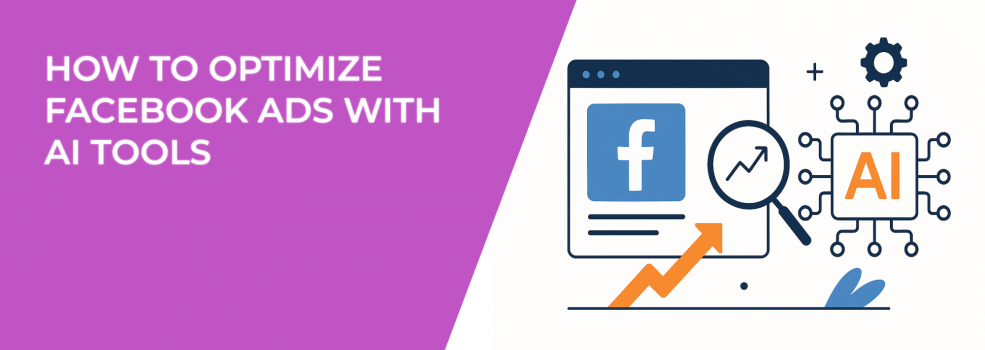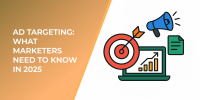Running Facebook Ads used to be straightforward. You picked an audience, set a budget, created an ad, and hoped for the best. Those days are gone. Now the platform is more competitive, the targeting options are constantly shifting, and the algorithm is smarter than ever.
The good news? You can fight smart with AI tools. These aren’t just “nice to have” extras — they’re becoming essential for advertisers who want better targeting, higher click-through rates, and lower ad costs without doubling their workload.
In this guide, we’ll break down exactly how to use AI to improve your Facebook Ads from top to bottom. You’ll see how to make better targeting decisions, test creative faster, optimize budgets automatically, and understand your performance like never before.
Why AI Is Changing Facebook Ads Forever
The main reason AI is such a game-changer? It never sleeps. It works in the background 24/7, analyzing data and spotting patterns that humans would miss — or that would take us weeks to figure out.
While you’re away from your desk, an AI tool could be:
-
Reviewing months of past campaign performance to find winning patterns.
-
Discovering new audience segments similar to your best customers.
-
Testing creative variations in small bursts so you don’t overspend on bad ads.
Instead of relying on “gut feeling” or slow, manual reporting, you can let AI constantly update your campaigns in real time. This means fewer wasted impressions, faster scaling when something works, and less budget leaking on underperforming ads.
And here’s something worth thinking about: AI doesn’t just help you react faster — it helps you predict what’s likely to happen before you even launch.
Step 1 — Use AI to Refine Audience Targeting
Audience targeting is where campaigns win or fail. You could have the most creative ad in the world, but if it’s shown to the wrong people, it’s money down the drain.
AI helps by doing more than just picking demographics or interests. It can:
-
Generate hyper-accurate lookalike audiences from your customer list, email subscribers, or high-value website visitors. These aren’t just “similar” audiences — AI looks for shared patterns in behavior, purchase timing, and engagement.
-
Identify hidden audience clusters by grouping together interests, behaviors, and demographics you might never think to combine.
-
Continuously refresh your targeting so that audience lists stay up-to-date as people’s online behavior changes.
Extra tips for AI-powered targeting:
-
Always feed the AI with rich first-party data — past purchases, customer lifetime value, and even lead scoring data if you have it.
-
Create separate lookalike audiences for different business goals. For example, a purchase lookalike will look different from a content-engagement lookalike.
-
Layer AI audience targeting with Facebook’s native tools (like exclusions) to avoid showing ads to people who’ve already converted.
If you’re using AI to create high-quality lookalike audiences, this detailed guide on optimizing campaign performance with lookalike audiences will help you squeeze even more conversions from your targeting strategy.
Step 2 — Automate Creative Testing
Even the most successful ads eventually hit fatigue. Costs rise, engagement drops, and you’re left scrambling for new ideas. Manually creating and testing fresh ad variations can eat up days.
This is where AI changes the game.
It can:
-
Generate multiple ad variations from a single piece of creative. For example, upload one image and get multiple background styles, text overlays, and crop versions in minutes.
-
Predict winning ads based on historical engagement and conversion data. This helps you test smarter, not just faster.
-
Run micro-tests — spending small amounts to validate new creative before committing serious budget.
Example: Say you’re selling a fitness product. You upload one lifestyle photo to your AI tool. Within an hour, it produces 10 variations: different colors, CTA text, and audience-specific edits (like adding “Busy Moms” to one headline and “Home Workouts” to another). The AI runs $5–$10 tests for each, finds the top two performers, and kills the rest before they waste your money.
If creative testing feels overwhelming, this beginner’s guide to creative testing breaks it down into manageable steps.
Step 3 — Let AI Handle Bid and Budget Adjustments
Bidding is one of the most time-sensitive parts of Facebook Ads. You could be overspending by 20% in the morning and underspending during your best converting hours without even realizing it.
AI bidding tools solve this by:
-
Shifting budget between ad sets based on real-time results.
-
Lowering bids when competition spikes and raising them when opportunities open up.
-
Detecting high-conversion time windows (like Friday evenings or Monday mornings) and allocating more spend during those periods.
Practical tip: If you have multiple campaigns running at once, set up rules so AI always prioritizes the one with the highest return on ad spend (ROAS) — even if that means pausing lower-performing ones temporarily.
Pairing AI bidding with automated campaign rules can give you even tighter control over costs and performance.
Step 4 — Boost Ad Relevance With Predictive Insights
Facebook rewards ads with high relevance scores by lowering your CPM and showing your ad in better placements. AI can help you get there before you launch.
Instead of guessing what might work, AI can analyze:
-
Past campaign formats (carousel, video, image) and their success rates.
-
Which placements (Instagram Reels, Facebook Stories, Marketplace) are best for your audience.
-
The tone of your copy — whether casual, urgent, or benefit-driven — that’s most likely to drive clicks.
Example insight: AI might discover that your audience responds 25% better to short-form video in Reels than to single-image ads in the News Feed. Acting on that before you start can save you hundreds of dollars in testing.
Step 5 — Monitor and Improve With AI-Powered Analytics
Most advertisers look at their campaign reports too late. By the time they see the problem, the budget is already gone.
AI analytics flips that. It monitors your campaigns live and flags issues before they drain your ad spend.
You can set it to alert you when:
-
Cost per lead creeps above your target.
-
Ad frequency rises too high, causing fatigue.
-
Click-through rates dip suddenly — signaling creative burnout.
Some tools even suggest specific fixes, like swapping creative or adjusting bids, so you can act in minutes instead of days.
If you’re not sure which KPIs to focus on, this breakdown of the 5 ad metrics that actually matter will make your optimization efforts far more effective.
The Future of Facebook Ads With AI
AI isn’t replacing marketers — it’s giving them more time to focus on strategy, messaging, and creative ideas. The advertisers who thrive in the next few years will be the ones who know how to combine human creativity with machine precision.
If you’re still managing Facebook Ads manually, now is the time to start experimenting with AI tools. Even small changes, like automated audience updates or creative testing, can lead to measurable improvements in your ROI.
The question is: how much budget will you save — and how much more could you earn — once AI is running the behind-the-scenes work for you?

